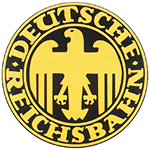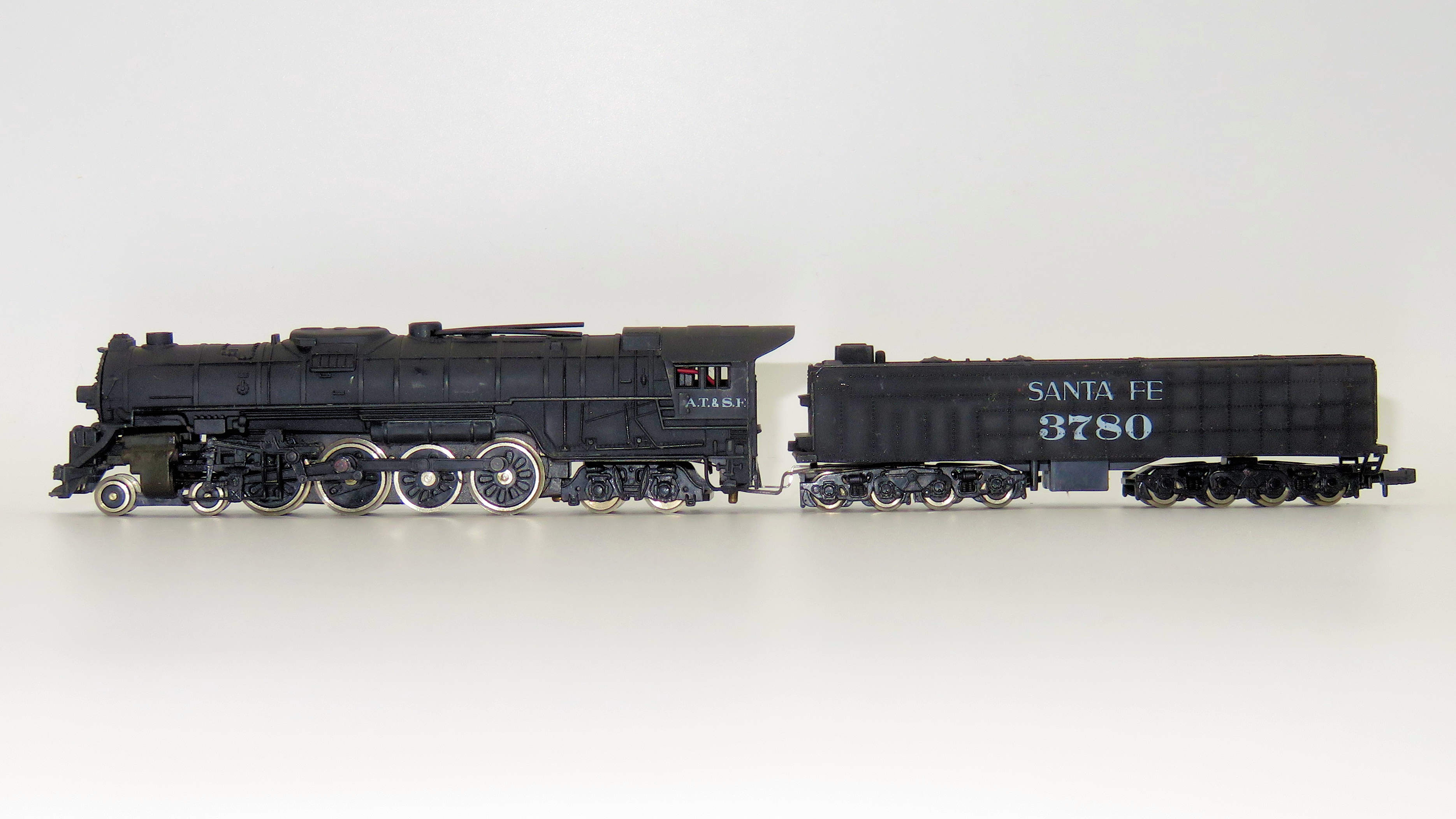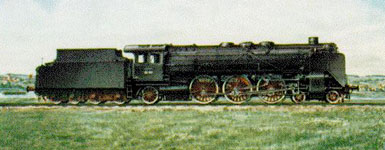Specific Item Information: Model: The Arnold BR 18 steam locomotive class BR 18 is a very impressive model with exceptional running performance. The model has extensive detail, comes in a beautiful livery, has prototypical “daylight” between boiler and chassis and has a finely detailed, fully operational Heusinger valve gear. This model would be great for any layout.
Special Features: Working head/tail lights; Metal Construction; Highly Detail Model.
Prototype: The German express locomotive, number 18 201 of the Deutsche Reichsbahn in East Germany, appeared in 1960–61 at Meiningen Steam Locomotive Works as a conversion of the Henschel-Wegmann train locomotive 61 002, the tender from 44 468 and parts of H 45 024 and Class 41. It is the fastest operational steam locomotive in the world.
The motivation for the conversion was first that, as a one-off, locomotive 61 002 could not really be used for scheduled services, and secondly that the research institute at VES-M Halle urgently needed locomotives that could do at least 160 km/h in order to test passenger coaches. For the conversion, a DR Class 22 new-design boiler, parts of the unsuccessful high-pressure locomotive, H 45 024, (outside cylinders, trailing wheels and rear section of the locomotive frame), as well as the tender of locomotive 44 468, were used. The inside cylinder of the three-cylinder engine was not however taken from 61 002, rather a new one was made. Other technical improvements were a Riggenbach counter-pressure brake and a Giesl ejector. The locomotive was streamlined at the front and over the boiler fittings. The new locomotive was given its number to commemorate the first German locomotive with a 4-6-2 ('Pacific') wheel arrangement, the Baden IV f of the Baden State Railways (later the DRG Class 18.2.
In 1967 number 18 201 was converted to oil-firing. After the changeover to computerized numbers the engine was given the number 02 0201-0. On 11 October 1972 during a trial run, it attained a top speed of 182.4 km/h or 113.3 mph. As a result, it is the fastest, operational steam locomotive in the world, and also holds the world record for the biggest driving wheels (2.30 m in diameter) ever to be fitted to an engine with a 4-6-2 wheel arrangement. When not required for test runs, locomotive 18 201 was also put in charge of scheduled express trains until well into the 1970s.
Since 1980 the locomotive has mainly been employed to haul heritage and special trains, often with a second tender, in order to be able to complete long-distance runs without the need to replenish its water. At its birthplace, in Meiningen Steam Locomotive Works the engine was handed over to the firm of Dampf-Plus on 4 April 2002 having been completely overhauled. Originally sporting a green livery with white stripes, the engine was repainted between 30 April 2002 and 10 July 2005 in a special red livery (RAL 3003, ruby red) sponsored by the model railway manufacturer, Roco. Today she is once again painted in her traditional green color (RAL 6020, chromium oxide green).
Special Features: Working head/tail lights; Metal Construction; Highly Detail Model.
Prototype: The German express locomotive, number 18 201 of the Deutsche Reichsbahn in East Germany, appeared in 1960–61 at Meiningen Steam Locomotive Works as a conversion of the Henschel-Wegmann train locomotive 61 002, the tender from 44 468 and parts of H 45 024 and Class 41. It is the fastest operational steam locomotive in the world.
The motivation for the conversion was first that, as a one-off, locomotive 61 002 could not really be used for scheduled services, and secondly that the research institute at VES-M Halle urgently needed locomotives that could do at least 160 km/h in order to test passenger coaches. For the conversion, a DR Class 22 new-design boiler, parts of the unsuccessful high-pressure locomotive, H 45 024, (outside cylinders, trailing wheels and rear section of the locomotive frame), as well as the tender of locomotive 44 468, were used. The inside cylinder of the three-cylinder engine was not however taken from 61 002, rather a new one was made. Other technical improvements were a Riggenbach counter-pressure brake and a Giesl ejector. The locomotive was streamlined at the front and over the boiler fittings. The new locomotive was given its number to commemorate the first German locomotive with a 4-6-2 ('Pacific') wheel arrangement, the Baden IV f of the Baden State Railways (later the DRG Class 18.2.
In 1967 number 18 201 was converted to oil-firing. After the changeover to computerized numbers the engine was given the number 02 0201-0. On 11 October 1972 during a trial run, it attained a top speed of 182.4 km/h or 113.3 mph. As a result, it is the fastest, operational steam locomotive in the world, and also holds the world record for the biggest driving wheels (2.30 m in diameter) ever to be fitted to an engine with a 4-6-2 wheel arrangement. When not required for test runs, locomotive 18 201 was also put in charge of scheduled express trains until well into the 1970s.
Since 1980 the locomotive has mainly been employed to haul heritage and special trains, often with a second tender, in order to be able to complete long-distance runs without the need to replenish its water. At its birthplace, in Meiningen Steam Locomotive Works the engine was handed over to the firm of Dampf-Plus on 4 April 2002 having been completely overhauled. Originally sporting a green livery with white stripes, the engine was repainted between 30 April 2002 and 10 July 2005 in a special red livery (RAL 3003, ruby red) sponsored by the model railway manufacturer, Roco. Today she is once again painted in her traditional green color (RAL 6020, chromium oxide green).
Model Information: Introduced in 2019. After nearly 4 years of waiting, Arnold finally delivered the high-speed German BR 02s and BR 18 express locomotives. These locomotive are highly detailed best of all they are all metal and very heavy. Arnold delivered several versions in both analog and DCC Digital.
Prototype History: The German DRG Class 02 (Baureihe 02 or BR 02) engines were standard (Einheitslokomotiven) express train locomotives with the Deutsche Reichsbahn-Gesellschaft. Number 02 001 was the first Einheitsdampflokomotive in the DRG to be completed.
In procuring a standard express train steam locomotive, the Deutsche Reichsbahn carried out a comparison between a superheated two-cylinder type (the DRG Class 01) and a four-cylinder compound locomotive (the Class 02). Ten examples of each type were built from 1925, and the Class 02 vehicles were given operating numbers 02 001 – 02 010. The first eight engines were manufactured in 1925 by the firm of Henschel, two more were built in 1926 by Maffei.
Because the Class 02 steam engines were badly designed, the compound engine could only produce a high level of power at speeds of over 70 km/h. In addition, below 1000 PSi its steam consumption was higher than that of the Class 01.
Compared with the Class 01s, these engines had a complicated, and therefore maintenance-intensive, drive; as a result no more were ordered. From 1937 to 1942 the vehicles were successively converted to two-cylinder operation and regrouped as Class 01s with the new numbers 01 011 and 01 233 – 01 241.
The first eight engines were equipped with 2'2' T 30 tenders; the other two with 2'2 T 32 tenders. Later on, the second tender was coupled to all of the first eight engines as well.
In procuring a standard express train steam locomotive, the Deutsche Reichsbahn carried out a comparison between a superheated two-cylinder type (the DRG Class 01) and a four-cylinder compound locomotive (the Class 02). Ten examples of each type were built from 1925, and the Class 02 vehicles were given operating numbers 02 001 – 02 010. The first eight engines were manufactured in 1925 by the firm of Henschel, two more were built in 1926 by Maffei.
Because the Class 02 steam engines were badly designed, the compound engine could only produce a high level of power at speeds of over 70 km/h. In addition, below 1000 PSi its steam consumption was higher than that of the Class 01.
Compared with the Class 01s, these engines had a complicated, and therefore maintenance-intensive, drive; as a result no more were ordered. From 1937 to 1942 the vehicles were successively converted to two-cylinder operation and regrouped as Class 01s with the new numbers 01 011 and 01 233 – 01 241.
The first eight engines were equipped with 2'2' T 30 tenders; the other two with 2'2 T 32 tenders. Later on, the second tender was coupled to all of the first eight engines as well.
Road Name History:  The Deutsche Reichsbahn, also known as the German Reich Railway or the German Imperial Railway, was the name of the German national railway created from the railways of the individual states of the German Empire following the end of World War I.
The Deutsche Reichsbahn, also known as the German Reich Railway or the German Imperial Railway, was the name of the German national railway created from the railways of the individual states of the German Empire following the end of World War I.
The company was founded in 1920 as the Deutsche Reichseisenbahnen when the Weimar Republic, formally known as Deutsches Reich (German Reich, hence the usage of the Reich in the name of the railway), took national control of the German railways, which had previously been run by the German states. In 1924 it was reorganised under the aegis of the Deutsche Reichsbahn-Gesellschaft (DRG), a nominally private railway company, which was 100% owned by the German state. In 1937 the railway was reorganised again as a state authority and given the name Deutsche Reichsbahn (DRB). After the Anschluss in 1938 the DR also took over the Bundesbahn Osterreich (BBO, Federal Railway of Austria).
The East and West German states were founded in 1949. East Germany took over the control of the DR on its territory and continued to use the traditional name Deutsche Reichsbahn, while the railway in West Germany became the Deutsche Bundesbahn (DB, German Federal Railway). The Austrian Osterreichische Bundesbahnen (OBB, Austrian Federal Railways) was founded in 1945, and was given its present name in 1947.
In January 1994, following the German union, the East German Deutsche Reichsbahn merged with the West German Deutsche Bundesbahn to form Germany's new national carrier, Deutsche Bahn AG, technically no longer a government agency but still a 100% state-owned joint stock company.

The company was founded in 1920 as the Deutsche Reichseisenbahnen when the Weimar Republic, formally known as Deutsches Reich (German Reich, hence the usage of the Reich in the name of the railway), took national control of the German railways, which had previously been run by the German states. In 1924 it was reorganised under the aegis of the Deutsche Reichsbahn-Gesellschaft (DRG), a nominally private railway company, which was 100% owned by the German state. In 1937 the railway was reorganised again as a state authority and given the name Deutsche Reichsbahn (DRB). After the Anschluss in 1938 the DR also took over the Bundesbahn Osterreich (BBO, Federal Railway of Austria).
The East and West German states were founded in 1949. East Germany took over the control of the DR on its territory and continued to use the traditional name Deutsche Reichsbahn, while the railway in West Germany became the Deutsche Bundesbahn (DB, German Federal Railway). The Austrian Osterreichische Bundesbahnen (OBB, Austrian Federal Railways) was founded in 1945, and was given its present name in 1947.
In January 1994, following the German union, the East German Deutsche Reichsbahn merged with the West German Deutsche Bundesbahn to form Germany's new national carrier, Deutsche Bahn AG, technically no longer a government agency but still a 100% state-owned joint stock company.
Brand/Importer Information: Founded in 1906 by Karl Arnold in Nürnberg, K. Arnold & Co. began its life producing tin toys and related items. They produced an extensive line of model ships, doll house items and other toys. In 1935, K. Arnold & Co. hired Max Ernst as their managing director. Ernst, not to be confused with the German realist artist of the same name, was a significant factor in the future of Arnold.
On Max Ernst's 1976 retirement, Arnold employed perhaps 200 to 250 people, using three facilities in the Nuernberg area. The Company continued under family control until 1995, when Arnold went into bankruptcy and was sold to Rivarossi of Italy. Rivarossi, in turn, also went bankrupt, leading to the sale of all assets to Hornby of the United Kingdom. Production is carried out in China.
From Wikipedia
On Max Ernst's 1976 retirement, Arnold employed perhaps 200 to 250 people, using three facilities in the Nuernberg area. The Company continued under family control until 1995, when Arnold went into bankruptcy and was sold to Rivarossi of Italy. Rivarossi, in turn, also went bankrupt, leading to the sale of all assets to Hornby of the United Kingdom. Production is carried out in China.
From Wikipedia
Item created by: gdm on 2019-11-15 13:59:32. Last edited by Alain LM on 2022-01-05 02:19:31
If you see errors or missing data in this entry, please feel free to log in and edit it. Anyone with a Gmail account can log in instantly.
If you see errors or missing data in this entry, please feel free to log in and edit it. Anyone with a Gmail account can log in instantly.










